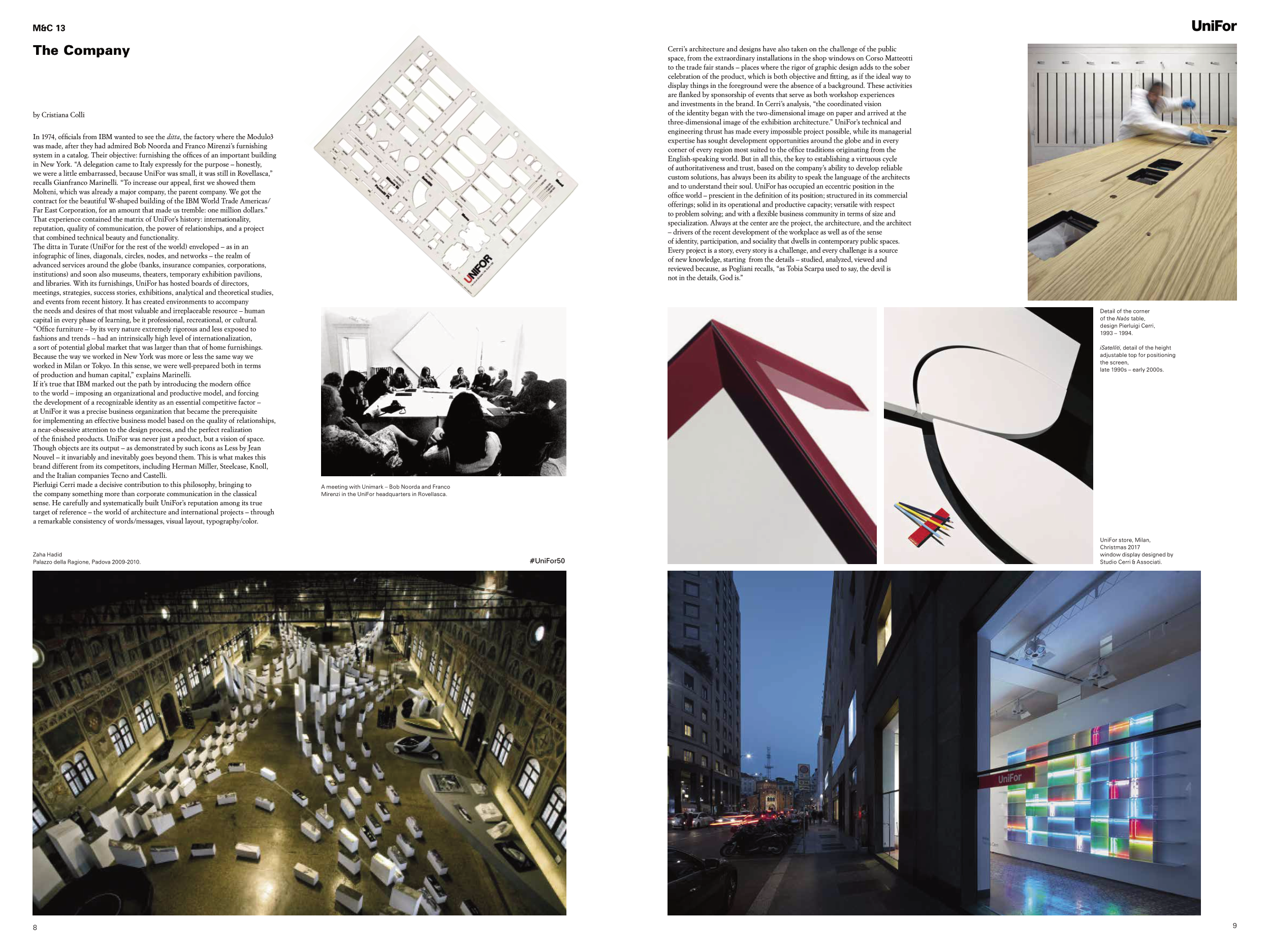8
9
M&C 13
Zaha Hadid
Palazzo della Ragione, Padova 2009-2010.
by Cristiana Colli
The Company
A meeting with Unimark – Bob Noorda and Franco
Mirenzi in the UniFor headquarters in Rovellasca.
Detail of the corner
of the Naòs table,
design Pierluigi Cerri,
1993 – 1994.
iSatelliti, detail of the height
adjustable top for positioning
the screen,
late 1990s – early 2000s.
UniFor store, Milan,
Christmas 2017
window display designed by
Studio Cerri & Associati.
#UniFor50
In 1974, officials from IBM wanted to see the ditta, the factory where the Modulo3
was made, after they had admired Bob Noorda and Franco Mirenzi’s furnishing
system in a catalog. Their objective: furnishing the offices of an important building
in New York. “A delegation came to Italy expressly for the purpose – honestly,
we were a little embarrassed, because UniFor was small, it was still in Rovellasca,”
recalls Gianfranco Marinelli. “To increase our appeal, first we showed them
Molteni, which was already a major company, the parent company. We got the
contract for the beautiful W-shaped building of the IBM World Trade Americas/
Far East Corporation, for an amount that made us tremble: one million dollars.”
That experience contained the matrix of UniFor’s history: internationality,
reputation, quality of communication, the power of relationships, and a project
that combined technical beauty and functionality.
The ditta in Turate (UniFor for the rest of the world) enveloped – as in an
infographic of lines, diagonals, circles, nodes, and networks – the realm of
advanced services around the globe (banks, insurance companies, corporations,
institutions) and soon also museums, theaters, temporary exhibition pavilions,
and libraries. With its furnishings, UniFor has hosted boards of directors,
meetings, strategies, success stories, exhibitions, analytical and theoretical studies,
and events from recent history. It has created environments to accompany
the needs and desires of that most valuable and irreplaceable resource – human
capital in every phase of learning, be it professional, recreational, or cultural.
“Office furniture – by its very nature extremely rigorous and less exposed to
fashions and trends – had an intrinsically high level of internationalization,
a sort of potential global market that was larger than that of home furnishings.
Because the way we worked in New York was more or less the same way we
worked in Milan or Tokyo. In this sense, we were well-prepared both in terms
of production and human capital,” explains Marinelli.
If it’s true that IBM marked out the path by introducing the modern office
to the world – imposing an organizational and productive model, and forcing
the development of a recognizable identity as an essential competitive factor –
at UniFor it was a precise business organization that became the prerequisite
for implementing an effective business model based on the quality of relationships,
a near-obsessive attention to the design process, and the perfect realization
of the finished products. UniFor was never just a product, but a vision of space.
Though objects are its output – as demonstrated by such icons as Less by Jean
Nouvel – it invariably and inevitably goes beyond them. This is what makes this
brand different from its competitors, including Herman Miller, Steelcase, Knoll,
and the Italian companies Tecno and Castelli.
Pierluigi Cerri made a decisive contribution to this philosophy, bringing to
the company something more than corporate communication in the classical
sense. He carefully and systematically built UniFor’s reputation among its true
target of reference – the world of architecture and international projects – through
a remarkable consistency of words/messages, visual layout, typography/color.
Cerri’s architecture and designs have also taken on the challenge of the public
space, from the extraordinary installations in the shop windows on Corso Matteotti
to the trade fair stands – places where the rigor of graphic design adds to the sober
celebration of the product, which is both objective and fitting, as if the ideal way to
display things in the foreground were the absence of a background. These activities
are flanked by sponsorship of events that serve as both workshop experiences
and investments in the brand. In Cerri’s analysis, “the coordinated vision
of the identity began with the two-dimensional image on paper and arrived at the
three-dimensional image of the exhibition architecture.” UniFor’s technical and
engineering thrust has made every impossible project possible, while its managerial
expertise has sought development opportunities around the globe and in every
corner of every region most suited to the office traditions originating from the
English-speaking world. But in all this, the key to establishing a virtuous cycle
of authoritativeness and trust, based on the company’s ability to develop reliable
custom solutions, has always been its ability to speak the language of the architects
and to understand their soul. UniFor has occupied an eccentric position in the
office world – prescient in the definition of its position; structured in its commercial
offerings; solid in its operational and productive capacity; versatile with respect
to problem solving; and with a flexible business community in terms of size and
specialization. Always at the center are the project, the architecture, and the architect
– drivers of the recent development of the workplace as well as of the sense
of identity, participation, and sociality that dwells in contemporary public spaces.
Every project is a story, every story is a challenge, and every challenge is a source
of new knowledge, starting from the details – studied, analyzed, viewed and
reviewed because, as Pogliani recalls, “as Tobia Scarpa used to say, the devil is
not in the details, God is.”


